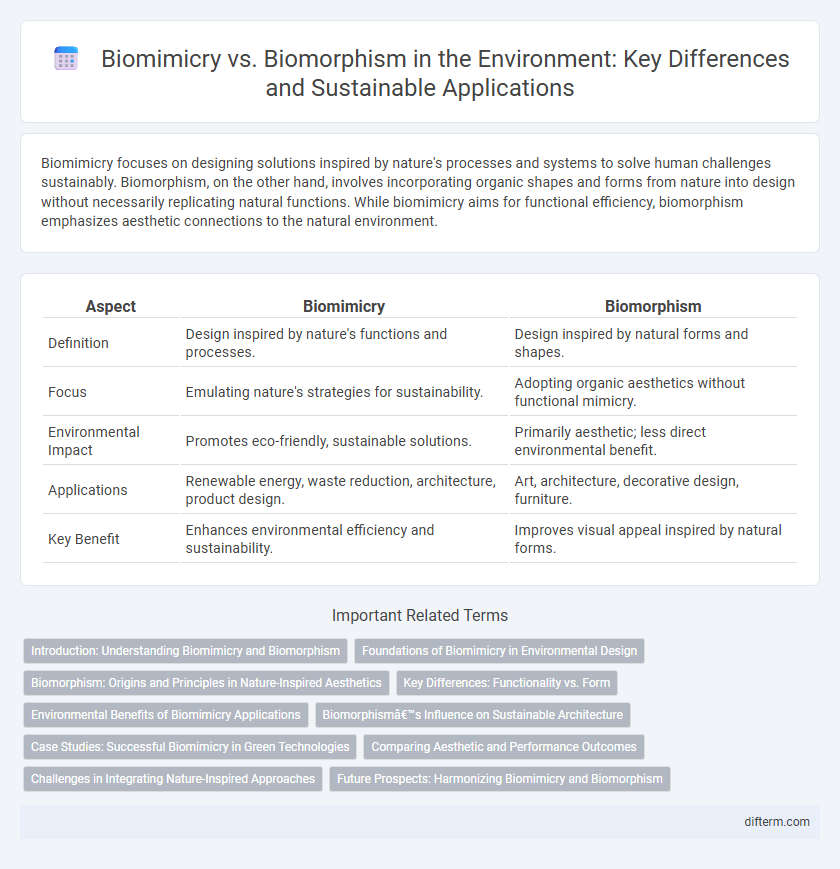Biomimicry focuses on designing solutions inspired by nature's processes and systems to solve human challenges sustainably. Biomorphism, on the other hand, involves incorporating organic shapes and forms from nature into design without necessarily replicating natural functions. While biomimicry aims for functional efficiency, biomorphism emphasizes aesthetic connections to the natural environment.
Table of Comparison
| Aspect | Biomimicry | Biomorphism |
|---|---|---|
| Definition | Design inspired by nature's functions and processes. | Design inspired by natural forms and shapes. |
| Focus | Emulating nature's strategies for sustainability. | Adopting organic aesthetics without functional mimicry. |
| Environmental Impact | Promotes eco-friendly, sustainable solutions. | Primarily aesthetic; less direct environmental benefit. |
| Applications | Renewable energy, waste reduction, architecture, product design. | Art, architecture, decorative design, furniture. |
| Key Benefit | Enhances environmental efficiency and sustainability. | Improves visual appeal inspired by natural forms. |
Introduction: Understanding Biomimicry and Biomorphism
Biomimicry involves designing sustainable innovations inspired by nature's models, systems, and elements to solve human challenges efficiently. Biomorphism, in contrast, emphasizes artistic and architectural forms that imitate natural shapes and structures without necessarily addressing ecological functionality. Understanding the distinctions between biomimicry's practical application and biomorphism's aesthetic focus is crucial for integrating nature-inspired concepts into environmental solutions.
Foundations of Biomimicry in Environmental Design
Biomimicry in environmental design draws inspiration from nature's time-tested patterns and strategies to solve human challenges sustainably by emulating biological processes and ecosystems. Its foundation lies in understanding natural models such as photosynthesis, water cycles, and resilience mechanisms to develop eco-efficient technologies, materials, and urban planning solutions that reduce environmental impact. Unlike biomorphism, which primarily uses organic forms for aesthetics, biomimicry emphasizes functional innovation based on ecological principles, promoting sustainable development and resource conservation.
Biomorphism: Origins and Principles in Nature-Inspired Aesthetics
Biomorphism, rooted in early 20th-century art and design, draws inspiration from organic and natural forms without directly mimicking specific living organisms, emphasizing abstract shapes and fluid lines. Its principles embrace the harmonious integration of natural patterns and structures into human-made environments, fostering aesthetic and functional connections to nature. This approach contrasts with biomimicry by focusing on visual and sensory resonance rather than technological or ecological replication.
Key Differences: Functionality vs. Form
Biomimicry emphasizes functionality by replicating nature's processes and systems to solve human challenges, promoting sustainability and efficiency. Biomorphism focuses on form, drawing inspiration from natural shapes and patterns primarily for aesthetic and design purposes. The key difference lies in biomimicry's goal to mimic natural functions for practical innovation, whereas biomorphism centers on mimicking natural appearances for visual impact.
Environmental Benefits of Biomimicry Applications
Biomimicry leverages natural processes and designs to create sustainable solutions that reduce environmental impact by optimizing resource efficiency and minimizing waste. Its applications in energy, water management, and agriculture mimic ecosystems to promote regenerative practices and enhance biodiversity. Unlike biomorphism, which primarily influences aesthetics, biomimicry drives innovation with measurable environmental benefits by integrating nature-inspired functionalities into technology and infrastructure.
Biomorphism’s Influence on Sustainable Architecture
Biomorphism's influence on sustainable architecture is evident in its use of organic forms and natural shapes to create energy-efficient buildings that harmonize with the environment. By mimicking natural patterns, biomorphic designs enhance passive cooling, natural lighting, and structural resilience, reducing the ecological footprint of constructions. This approach integrates aesthetic innovation with sustainability goals, promoting environmental balance and resource conservation in modern architecture.
Case Studies: Successful Biomimicry in Green Technologies
Biomimicry has revolutionized green technologies through case studies like the Eastgate Centre in Zimbabwe, which mimics termite mounds for natural cooling and ventilation, reducing energy consumption by up to 90%. Another success is Japan's Shinkansen Bullet Train, inspired by the kingfisher's beak, which minimizes noise pollution and improves aerodynamics. These examples demonstrate how biomimicry leverages nature's designs to create sustainable, energy-efficient solutions surpassing the aesthetic-driven biomorphism approach.
Comparing Aesthetic and Performance Outcomes
Biomimicry leverages natural processes and structures to enhance sustainability and efficiency in design, often yielding high-performance solutions that directly address environmental challenges. Biomorphism prioritizes organic shapes and forms inspired by nature's aesthetics, emphasizing visual harmony and emotional connection rather than functional imitation. While biomimicry excels in optimizing performance and ecological impact, biomorphism enriches aesthetic appeal, influencing user experience and cultural significance in environmentally-conscious designs.
Challenges in Integrating Nature-Inspired Approaches
Biomimicry and biomorphism present unique challenges in integrating nature-inspired approaches into sustainable design due to their differing focuses; biomimicry emphasizes replicating biological functions, while biomorphism prioritizes aesthetic forms. Translating complex natural systems into practical applications often faces technological limitations, material constraints, and scalability issues. Overcoming these obstacles requires interdisciplinary collaboration and advanced computational modeling to achieve effective and eco-friendly solutions.
Future Prospects: Harmonizing Biomimicry and Biomorphism
Future prospects in environmental design emphasize harmonizing biomimicry and biomorphism to foster sustainable innovation. Integrating biomimicry's functional emulation of natural processes with biomorphism's aesthetic inspiration from organic forms can enhance eco-friendly architecture and urban planning. This synergy supports resilient ecosystems by promoting resource efficiency, energy conservation, and biodiversity preservation in future environmental solutions.
biomimicry vs biomorphism Infographic

 difterm.com
difterm.com